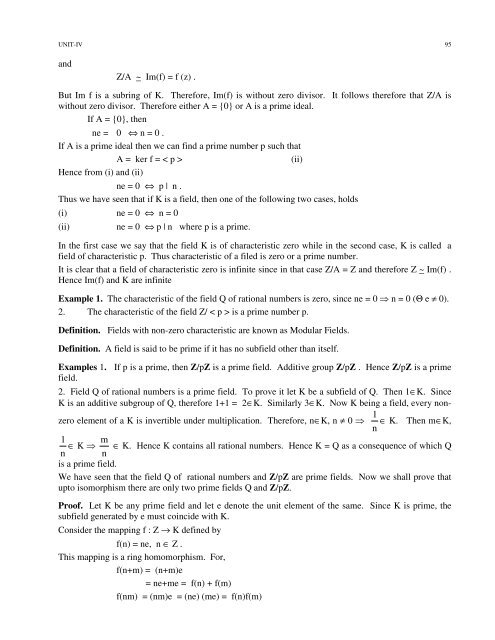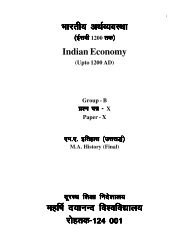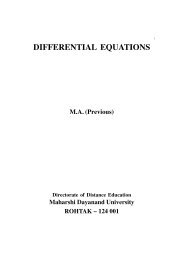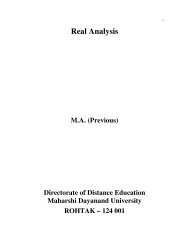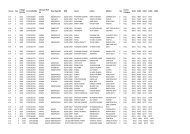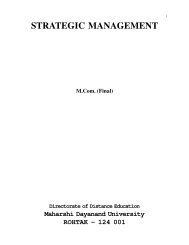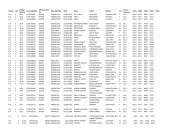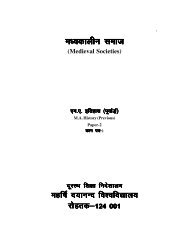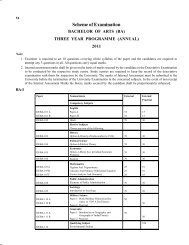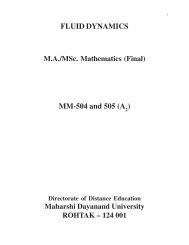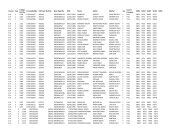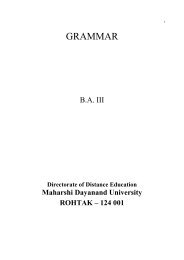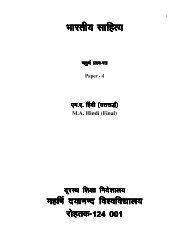Advanced Abstract Algebra - Maharshi Dayanand University, Rohtak
Advanced Abstract Algebra - Maharshi Dayanand University, Rohtak
Advanced Abstract Algebra - Maharshi Dayanand University, Rohtak
Create successful ePaper yourself
Turn your PDF publications into a flip-book with our unique Google optimized e-Paper software.
UNIT-IV 95<br />
and<br />
Z/A ~ Im(f) = f (z) .<br />
But Im f is a subring of K. Therefore, Im(f) is without zero divisor. It follows therefore that Z/A is<br />
without zero divisor. Therefore either A = {0} or A is a prime ideal.<br />
If A = {0}, then<br />
ne = 0 ⇔ n = 0 .<br />
If A is a prime ideal then we can find a prime number p such that<br />
A = ker f = < p ><br />
(ii)<br />
Hence from (i) and (ii)<br />
ne = 0 ⇔ p | n .<br />
Thus we have seen that if K is a field, then one of the following two cases, holds<br />
(i) ne = 0 ⇔ n = 0<br />
(ii)<br />
ne = 0 ⇔ p | n where p is a prime.<br />
In the first case we say that the field K is of characteristic zero while in the second case, K is called a<br />
field of characteristic p. Thus characteristic of a filed is zero or a prime number.<br />
It is clear that a field of characteristic zero is infinite since in that case Z/A = Z and therefore Z ~ Im(f) .<br />
Hence Im(f) and K are infinite<br />
Example 1. The characteristic of the field Q of rational numbers is zero, since ne = 0 n = 0 (Θ e ≠ 0).<br />
2. The characteristic of the field Z/ < p > is a prime number p.<br />
Definition. Fields with non-zero characteristic are known as Modular Fields.<br />
Definition. A field is said to be prime if it has no subfield other than itself.<br />
Examples 1. If p is a prime, then Z/pZ is a prime field. Additive group Z/pZ . Hence Z/pZ is a prime<br />
field.<br />
2. Field Q of rational numbers is a prime field. To prove it let K be a subfield of Q. Then 1∈K. Since<br />
K is an additive subgroup of Q, therefore 1+1 = 2∈K. Similarly 3∈K. Now K being a field, every nonzero<br />
element of a K is invertible under multiplication. Therefore, n∈K, n ≠ 0 ∈ K. Then m∈K,<br />
1<br />
n<br />
1 m ∈ K ∈ K. Hence K contains all rational numbers. Hence K = Q as a consequence of which Q<br />
n n<br />
is a prime field.<br />
We have seen that the field Q of rational numbers and Z/pZ are prime fields. Now we shall prove that<br />
upto isomorphism there are only two prime fields Q and Z/pZ.<br />
Proof. Let K be any prime field and let e denote the unit element of the same. Since K is prime, the<br />
subfield generated by e must coincide with K.<br />
Consider the mapping f : Z → K defined by<br />
f(n) = ne, n ∈ Z .<br />
This mapping is a ring homomorphism. For,<br />
f(n+m) = (n+m)e<br />
= ne+me = f(n) + f(m)<br />
f(nm) = (nm)e = (ne) (me) = f(n)f(m)


